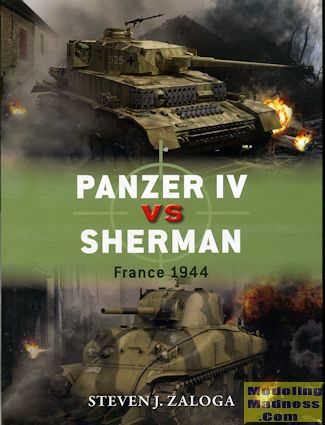 This latest
addition to Osprey's Duel series is another tank pair. This time it is the
Panzer IV and the Sherman. One might wonder about these being even close to
being equals as the Panzer IV was developed in the mid 1930 while the Sherman
was developed in the early 1940s. Well, in fact, these two tanks were actually
pretty much the same as they both had 75mm guns and had both seen combat action
and had been upgraded to some extent, the Panzer IV much more than the Sherman.
This latest
addition to Osprey's Duel series is another tank pair. This time it is the
Panzer IV and the Sherman. One might wonder about these being even close to
being equals as the Panzer IV was developed in the mid 1930 while the Sherman
was developed in the early 1940s. Well, in fact, these two tanks were actually
pretty much the same as they both had 75mm guns and had both seen combat action
and had been upgraded to some extent, the Panzer IV much more than the Sherman.
Initially, the Panzer IV was an infantry support tank with
the Panzer III chosen to handle any tank vs tank action, and in the early years
of the war, this worked well. However, once the Germans came up against the T-34
and the KV-1 during Barbarossa, it was painfully obvious that the Panzer III had
seen its day and while it continued to be used, it was the one that became the
infantry support tank. Thanks to the large size of the turret ring in the Panzer
IV, it was able to be upgunned, while the Panzer III could not once a certain
point was reached.
So it was that the Panzer IV came to be armed with a nice
75mm gun and it is the later ausf H and ausf J tanks that were met in France
after the Normandy invasion.
The M4 Sherman was developed from the earlier M2 and M3
medium tanks, keeping the same automotive section from the earlier tanks and
putting the 75mm gun from the M3 in a proper turret. The tank's armor protection
wasn't the best and there were issues with stored ammunition going up when the
tank's armor was penetrated. While that was partially fixed later on, many
tankers preferred the older method as it allowed them to carry more ammunition.
As a minor fix, the areas opposite ammo storage in the turret had sections of
armor plate welded over them.
The Sherman also had a bit of a secret weapon when it came to
fighting in the bocage areas of France. This came in the form of various designs
of cutters on the front of the tank, allowing the Sherman to cut right through
this thick vegetation. This made much of the cover used by German forces
vulnerable and resulted in many actions in favor of the Allies during operation
Cobra.
In fact, it is during this operation that the book
concentrates its material. During this period the Allies had pretty much
overwhelming materiel superiority while the Germans had trouble keeping units
cohesive. Due to the short fighting distances, the Sherman was able to penetrate
the Panzer IV's thicker armor and thanks to its numbers and automotive
reliability, was able to prevail in the end.
Typical of this series we get a development history of both
types, information on the training of the crews as well as how the tank was
deployed. This continues with quite a few action reports involving the two
tanks. This is enhanced by a lot of neat period photos, some nice art work and
an interesting stats section at the end of the book. In all, it is a great read
for the armchair general and a book that I can highly recommend to you.
June 2015
For more on the complete line of Osprey books,
visit http://ospreygrp.com. In the US, it is
Osprey Direct at 443 Park Avenue South, New York, NY 10016, where you can
get a catalogue of available books.
If you would like your product reviewed fairly and quickly, please contact
me or see other details in the Note to
Contributors.
 This latest
addition to Osprey's Duel series is another tank pair. This time it is the
Panzer IV and the Sherman. One might wonder about these being even close to
being equals as the Panzer IV was developed in the mid 1930 while the Sherman
was developed in the early 1940s. Well, in fact, these two tanks were actually
pretty much the same as they both had 75mm guns and had both seen combat action
and had been upgraded to some extent, the Panzer IV much more than the Sherman.
This latest
addition to Osprey's Duel series is another tank pair. This time it is the
Panzer IV and the Sherman. One might wonder about these being even close to
being equals as the Panzer IV was developed in the mid 1930 while the Sherman
was developed in the early 1940s. Well, in fact, these two tanks were actually
pretty much the same as they both had 75mm guns and had both seen combat action
and had been upgraded to some extent, the Panzer IV much more than the Sherman.